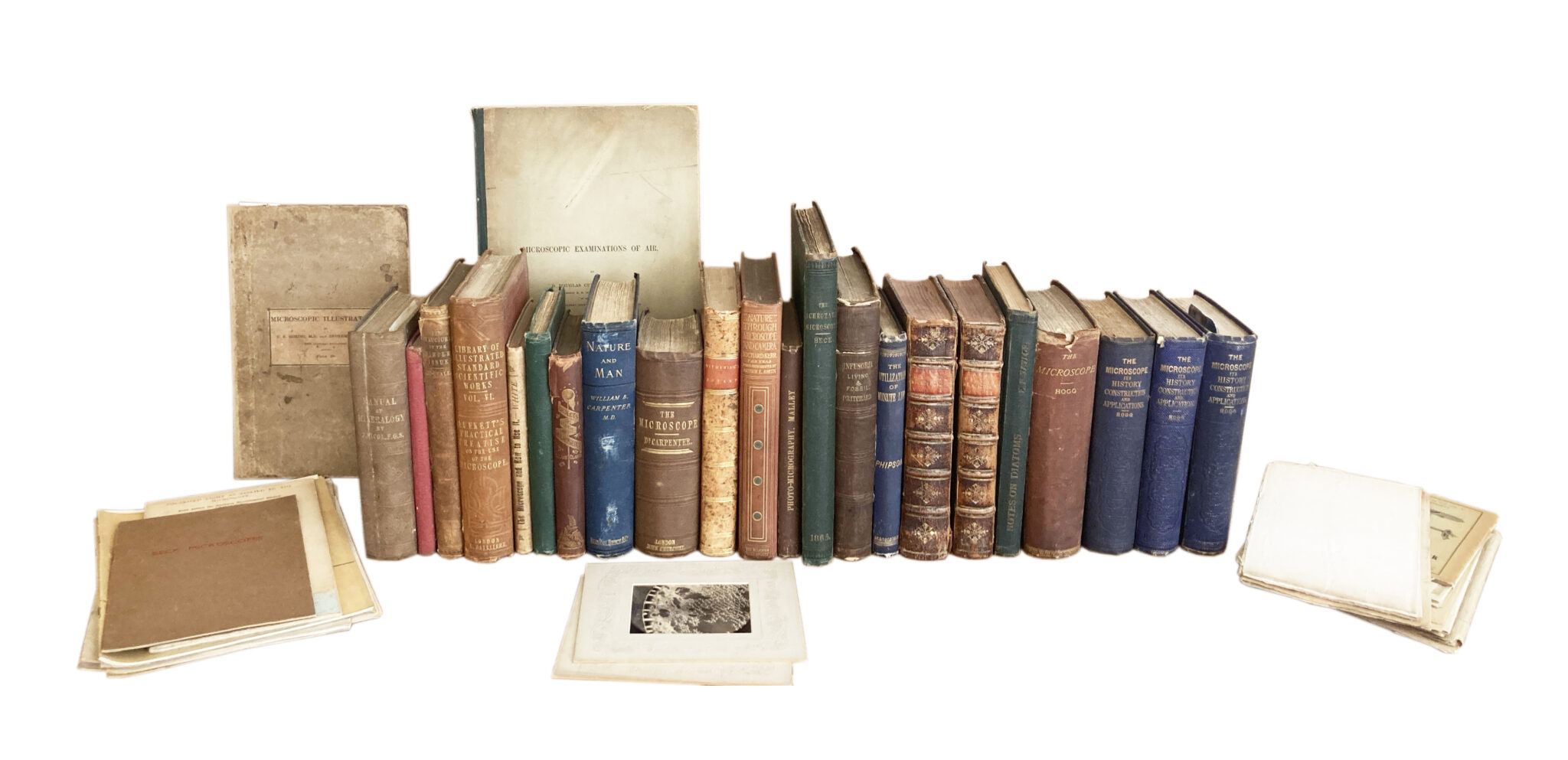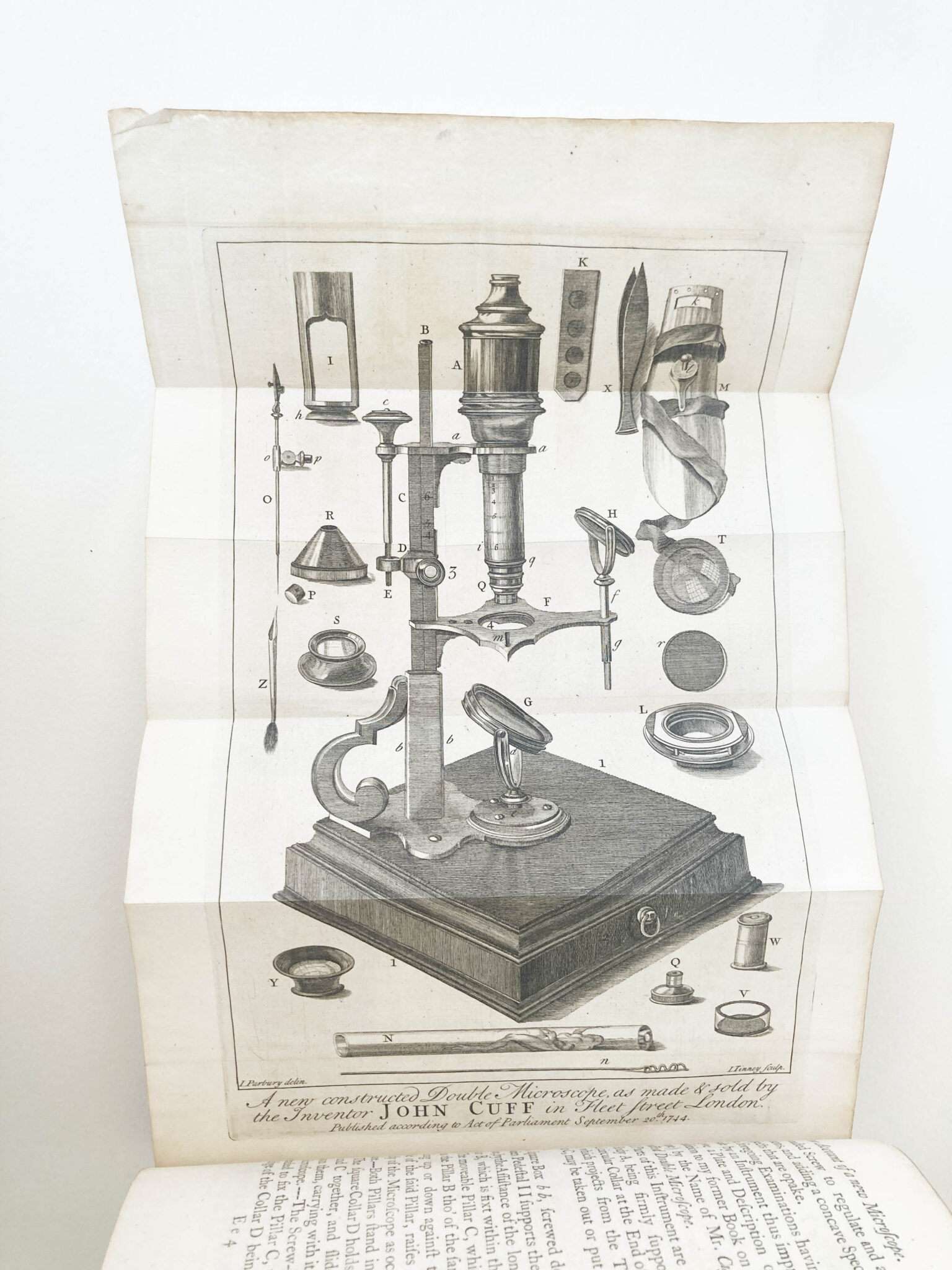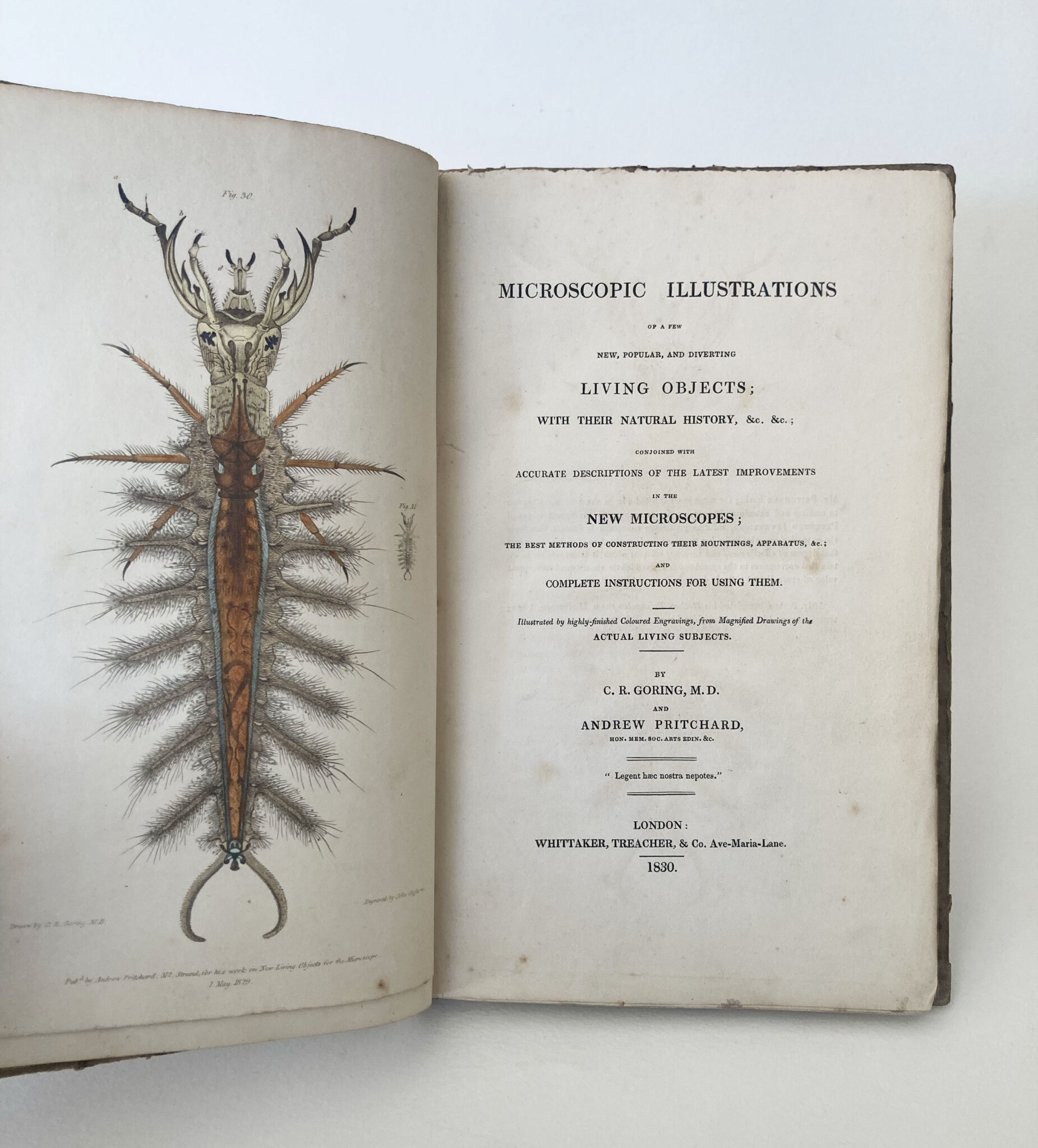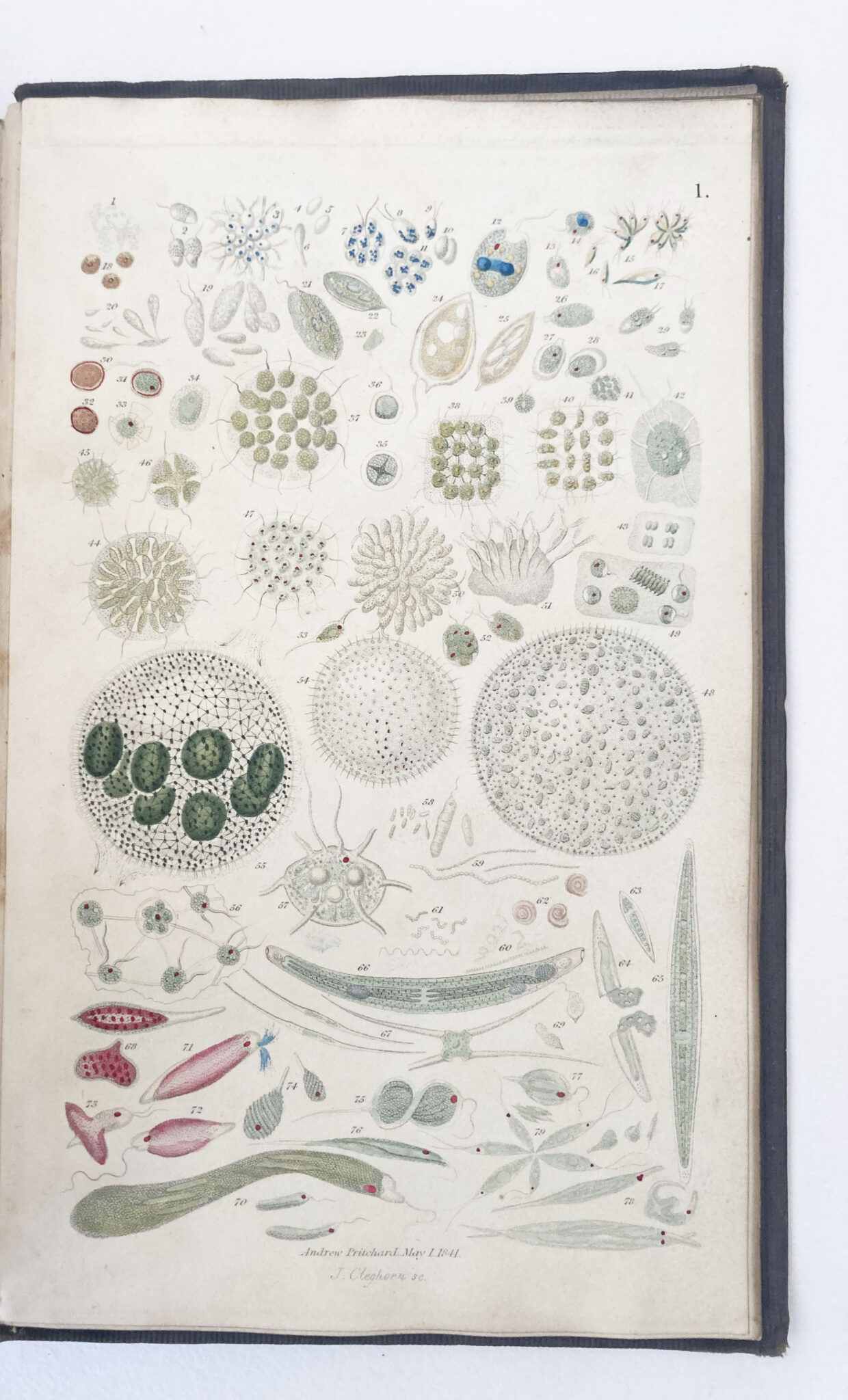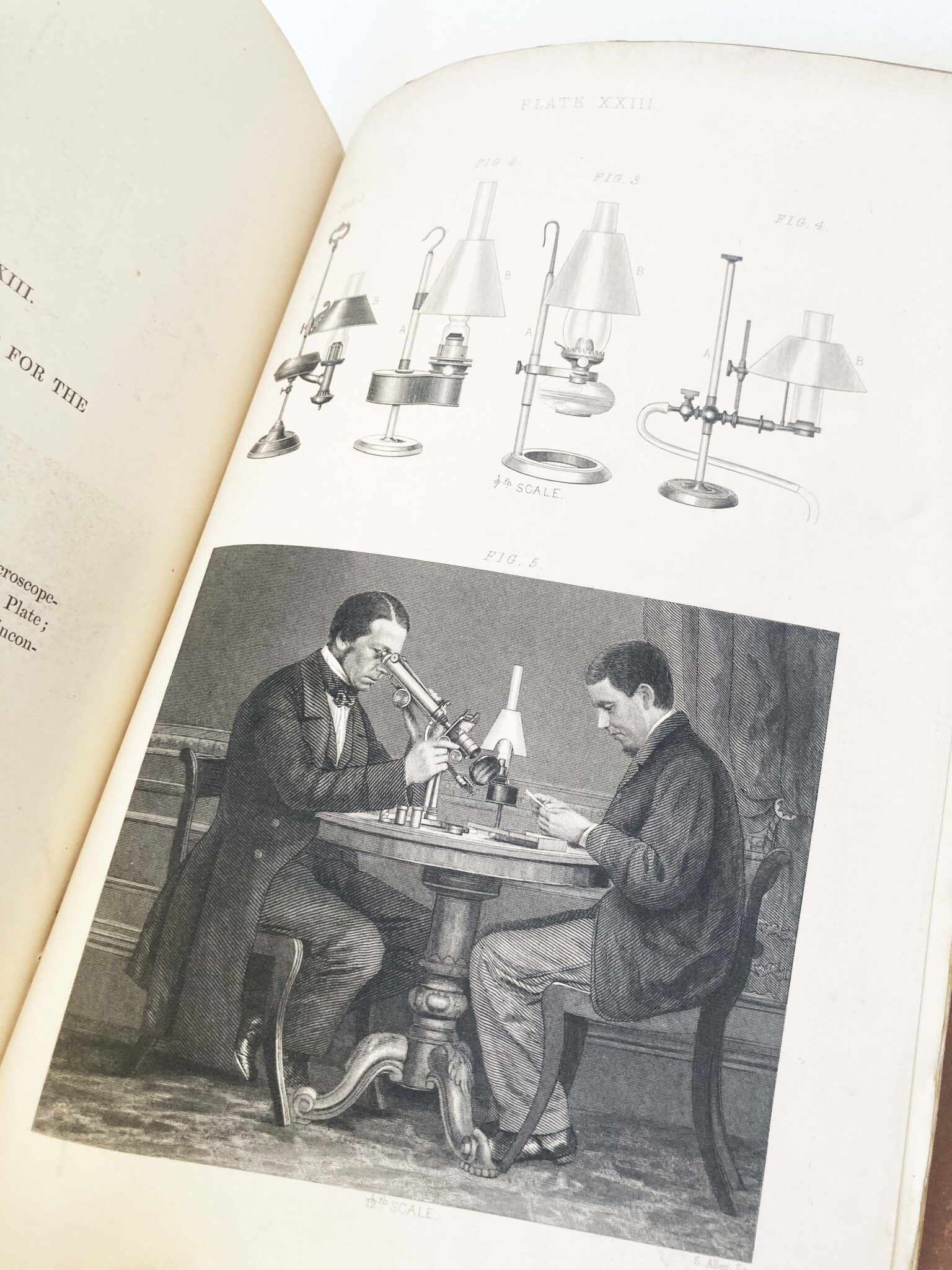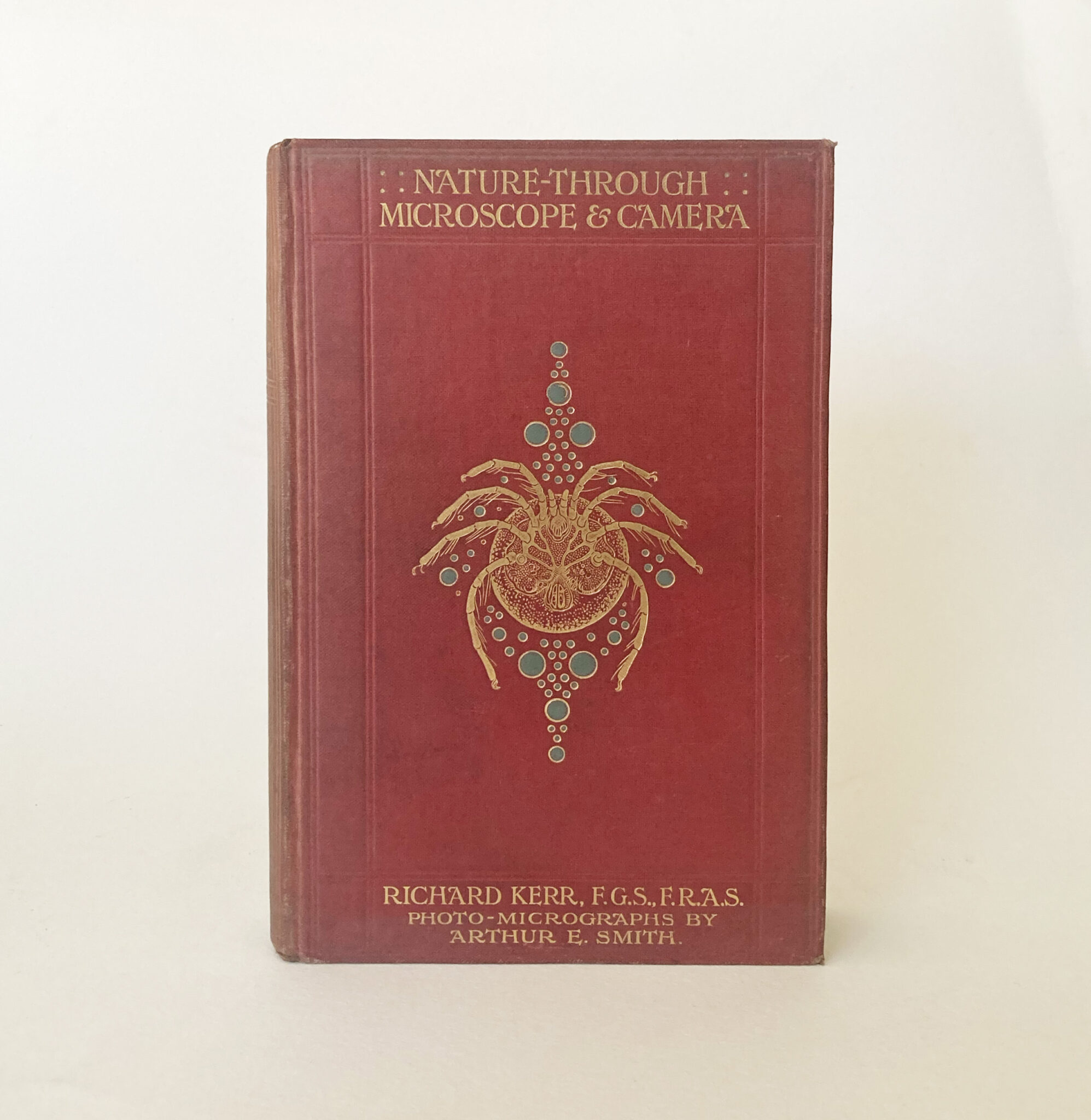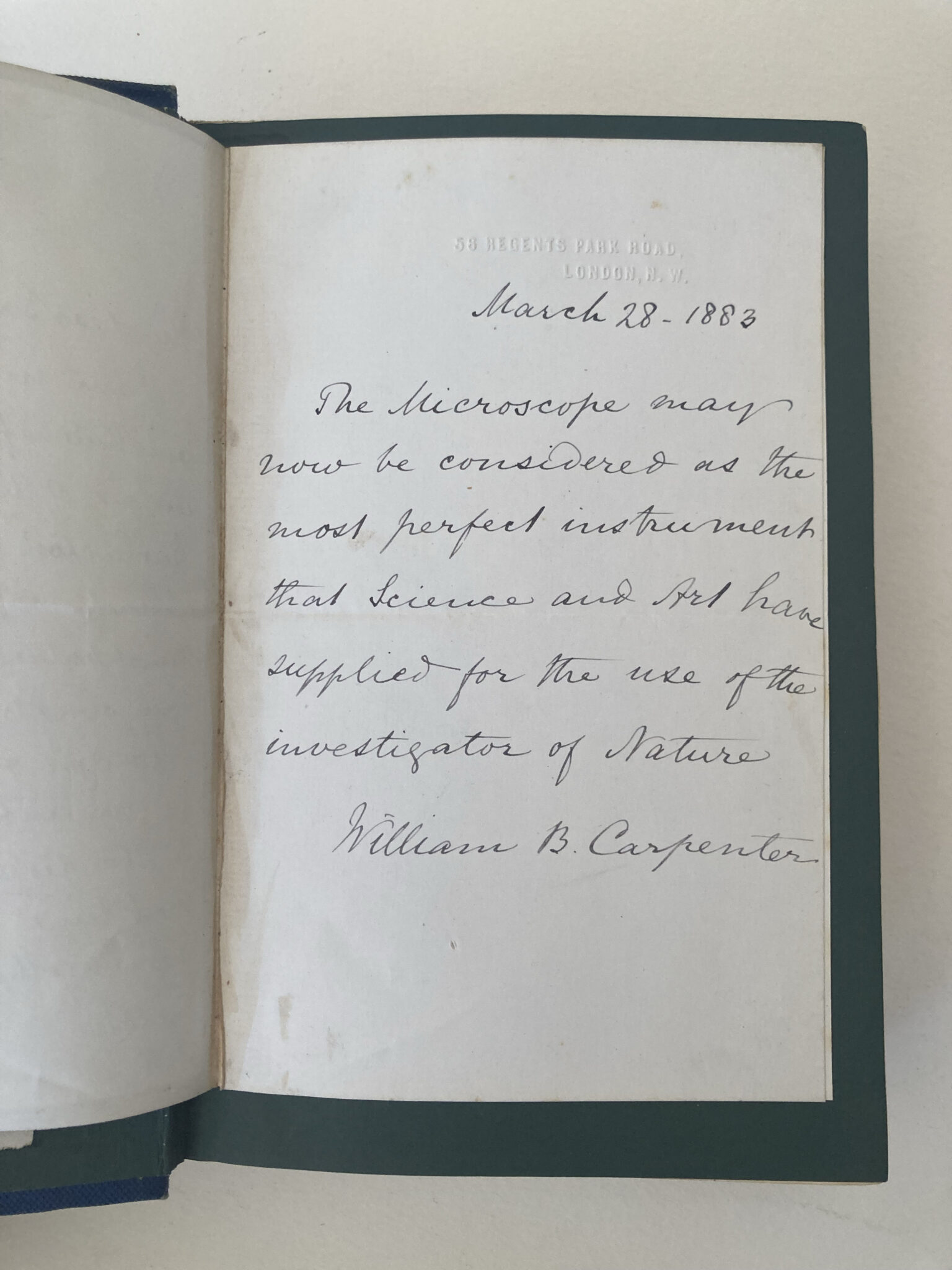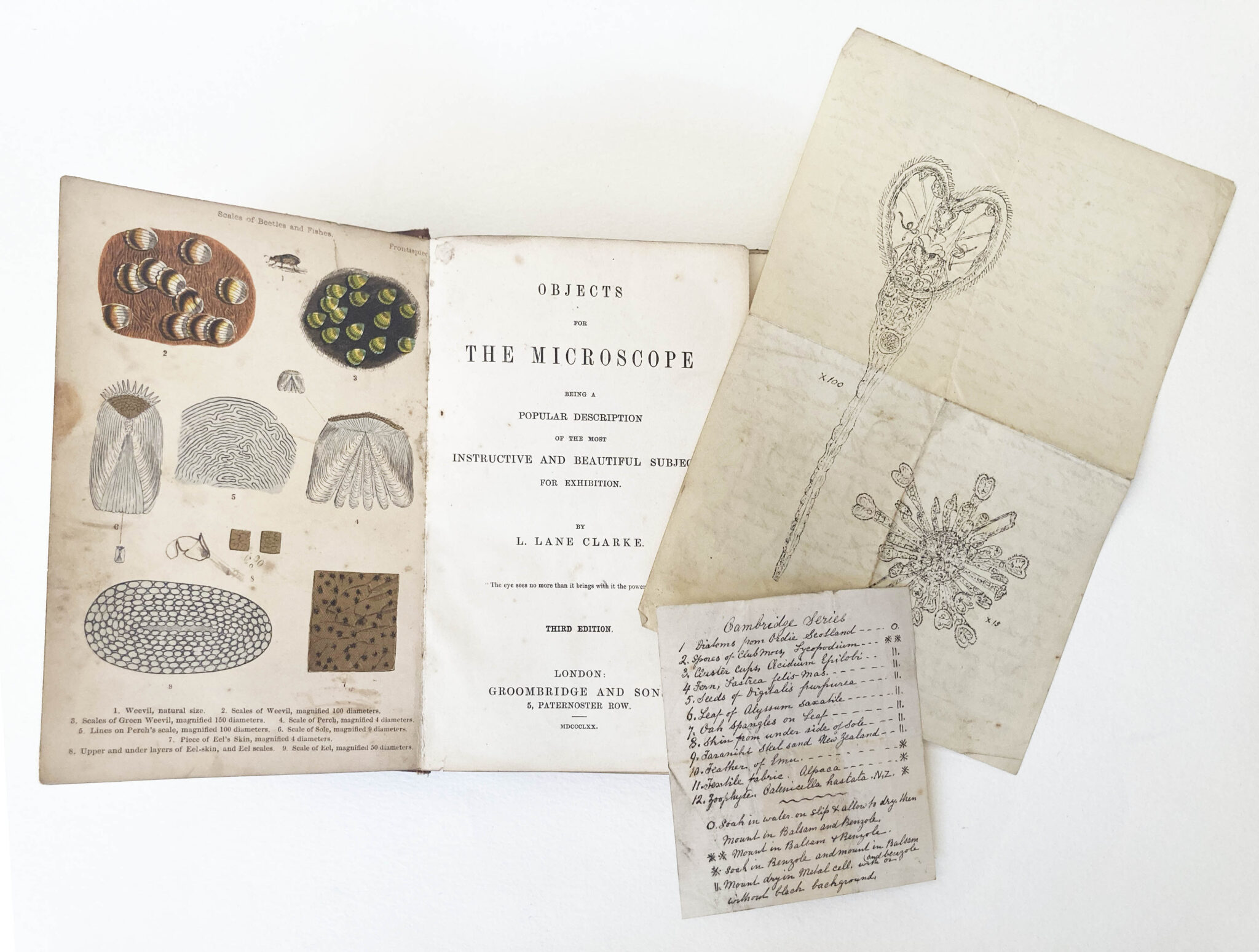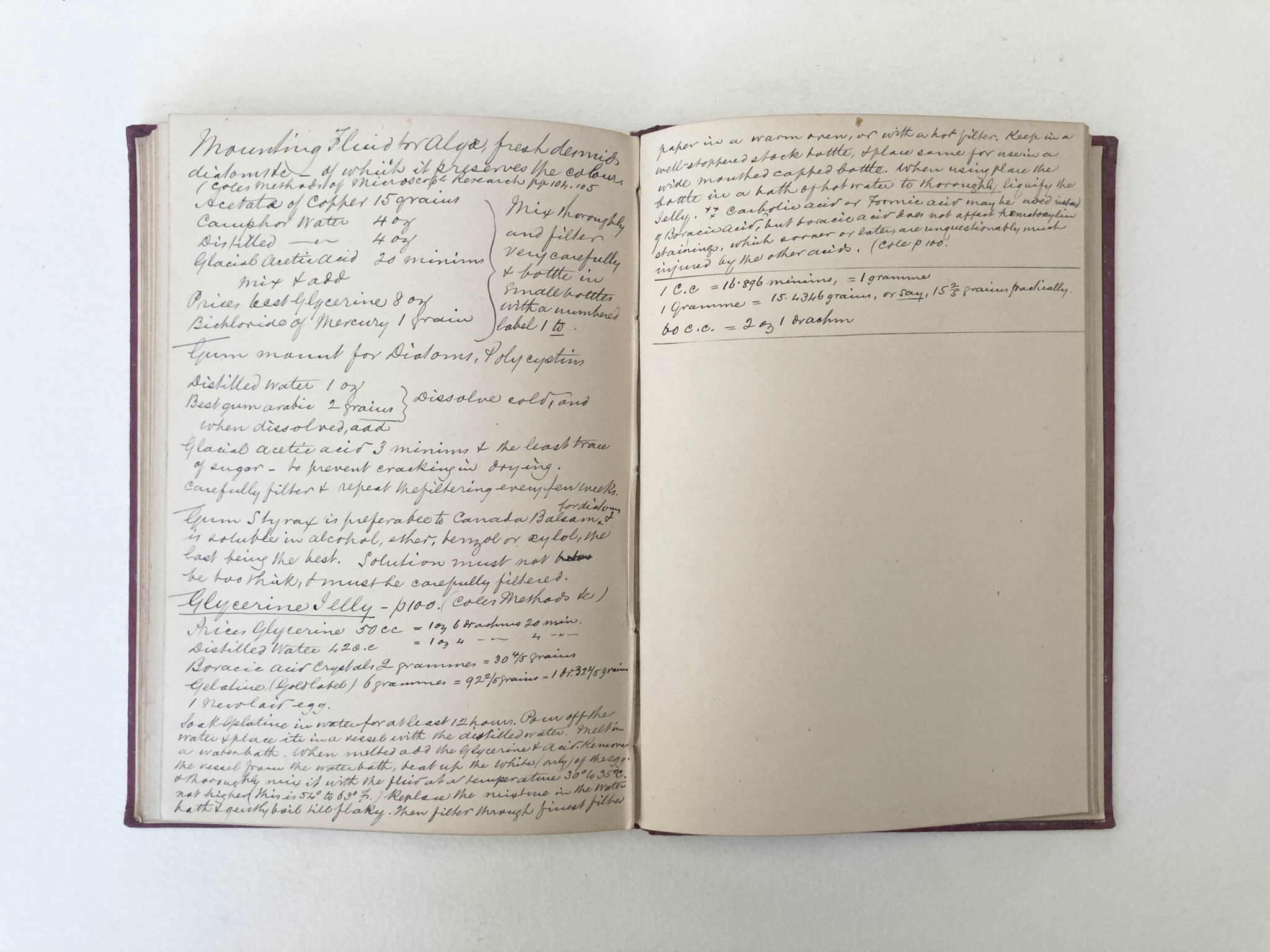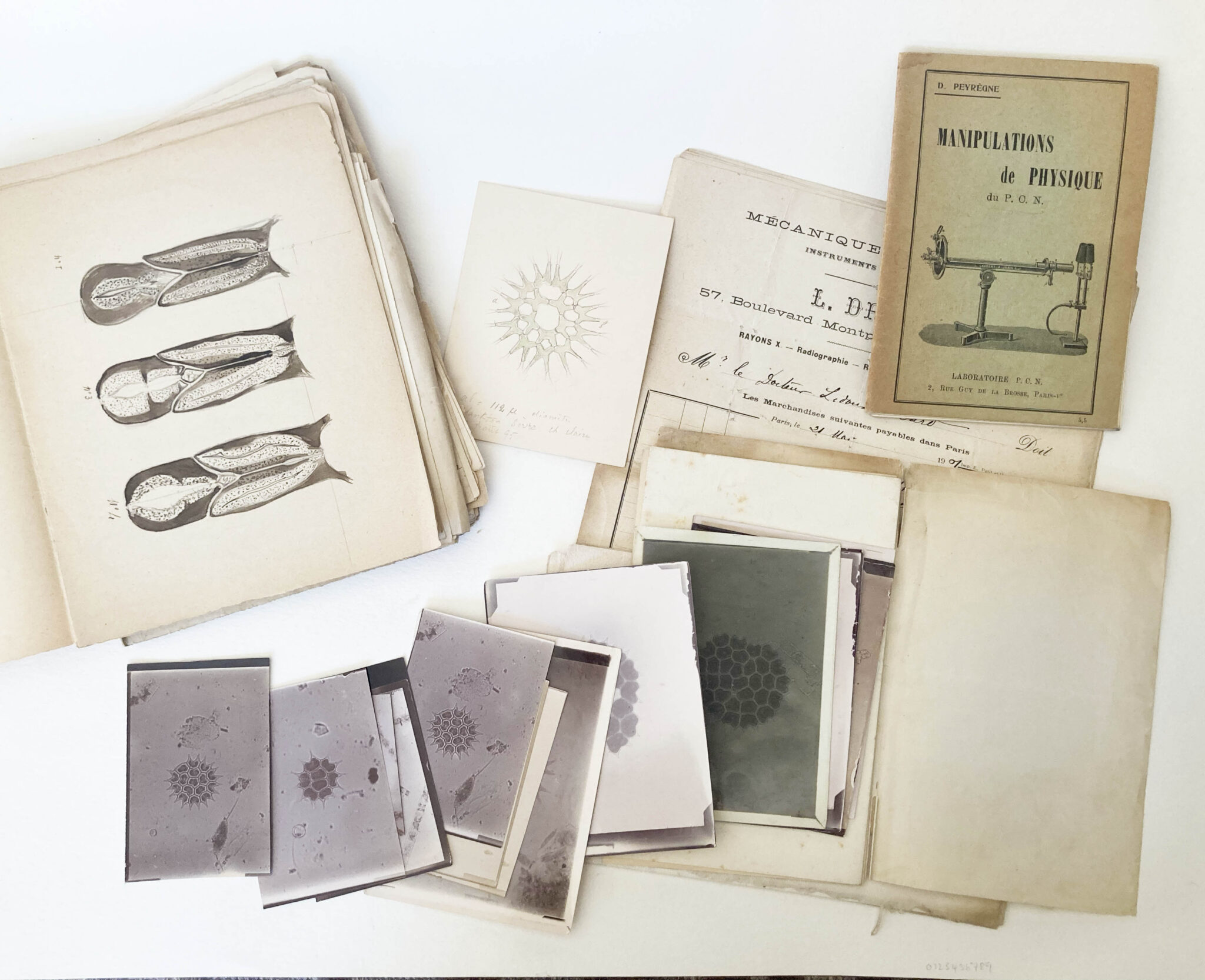THE MICROSCOPIST’S LIBRARY: an important collection of books, association copies, and manuscripts
Stock Number: 2404X13001
£5,750
A comprehensive collection of early microscopy books, many fine copies, associations, with manuscript material and original photo-micrographs – 1744 to 1929
Dimensions
85cm (linear measure)
Circa
1744–1929
Maker
Richard Beck, Andrew Pritchard, Henry Baker, Jabez Hogg, John Quekett, William Carpenter, et al.
Country of manufacture
UK and Ireland
Description
“The Microscope may now be considered as the most perfect instrument that Science and Art have supplied for the use of the investigator of Nature” – William B. Carpenter (see No. 20)
Highlights:
– Jabez Hogg’s own working copy of The Microscope, fourth edition (1859), with many manuscript revisions for later editions
– Attractive first editions of the three other classics of Victorian microscopy: Quekett’s Practical Treatise (1848), Carpenter’s The Microscope and Its Revelations (1856), and Richard Beck’s Achromatic Microscope (1865)
– Henry Baker’s foundational The Microscope Made Easy (1744) and Employment for the Microscope (1753) in matching period bindings, with good provenance
– Working copies from microscopists F.B. Taylor and Charles Elcock, including Elcock’s recipes for slide mounting solutions
– A significant collection of manuscripts, photographs and documents from the working archive of pathologist and parasitologist Marie-Auguste Ledoux-Lebard
Condition is generally excellent: these books have been acquired as the ‘best copies’ – notably the Baker, Quekett, Carpenter, and (for different reasons) Hogg. For more information or photographs of any item please send an inquiry form or contact us at [email protected].
Full listing in chronological order:
1. BAKER, Henry, The Microscope Made Easy (London: R. Dodsley, M. Cooper and John Cuff), 1744 [WITH:] Employment for the Microscope (London: R. Dodsley, M. Cooper and John Cuff), 1753
Wonderful copies, in contemporary full leather bindings; early ownership signatures of the Northumbrian antiquary Charles Francis Forster (bef.1732–c.1807), later bookplate of Charles Longuet Higgins (1806–1885). The Microscope Made Easy is a third edition, notable for the inclusion, out of sequence of a plate of the recently invented solar microscope. Employment (first edition) is famous for the inclusion of a beautiful plate showing the ‘Cuff type’ microscope, made by John Cuff (c.1708–c.1772), who partly financed these works. Baker (1698–1775) was a famous naturalist, publisher, educationalist and FRS. There is a possible family connection here, as Baker is known to have become interested in the education of the deaf through his relative Rev. John Forster.
2. WITHERING, William, A Systematic Arrangement of British Plants (London: T. Cadell et al.), 1801
First volume of Withering’s famous Botany, containing the plate with the ‘Withering type’ botanical microscope. A very good copy, noting only two very small wormholes to the outer margin of the second half of the book.
3. GORING, C.R., and PRITCHARD, Andrew, Microscopic Illustrations (London: Whittaker, Treacher, and Co.), 1830
A scarce and beautifully illustrated work, the second by this pair of authors, with chapters on new developments in microscope design.
4. PRITCHARD, Andrew, A History of Infusoria, Living and Fossil (London: Whittaker and Co.), 1841
First edition in original cloth binding. A significant work, following on from (and arranged according to) C.G. Ehrenberg’s Die Infusionsthierchen. Many beautifully engraved plates. A good copy: spine a little weak, with one panel loose (could be easily affixed); interesting provenance, from the St James’ Literary & Scientific Society, with small blindstamp to title-page, also a small bookplate from the Birmingham Microscopists’ & Naturalists’ Union
5. QUEKETT, John, A Practical Treatise on the Use of the Microscope (London: Hippolyte Bailliere), 1848
A fine first edition of this classic text, the first of the major Victorian treatises on the microscope. In original cloth binding with gilt spine titles; presentation copy from the publisher to Dr A. Taylor. Nine plates and numerous wood engravings to the text. Adverts with price lists for Andrew Ross, Smith & Beck, C.M. Topping and J.B. Dancer to the rear.
6. CARPENTER, William, The Microscope: and Its Revelations (London: John Churchill), 1856
First edition in original cloth, with 345 wood engravings to the text. Original booksellers label inside front cover, otherwise fine. For Carpenter’s autograph see No. 19.
7. HOGG, Jabez, The Microscope: Its History, Construction, and Application (London: George Routledge & Co.), 1858
Good copy in original cloth. Third edition.
8. HOGG, Jabez, The Microscope: Its History, Construction, and Application (London: George Routledge & Co.), 1859
Jabez Hogg’s own working copy of the fourth edition of this classic work, with numerous corrections and alterations throughout, as well as two small pencil portraits and a transcription of the ditty ‘Big fleas have little fleas…’ at the appropriate place in the text. Perhaps most instructive are the many comments on the illustrations, which were indeed substantially improved in the sixth edition (but not the fifth; see Nos. 9 and 14).
9. HOGG, Jabez, The Microscope: Its History, Construction, and Application (London: George Routledge & Co.), 1861
A good copy in original cloth; identical to the fifth edition.
10. BEALE, Lionel S., How to Work with the Microscope (London: John Churchill), 1857
First edition of Beale’s handy little textbook of microtechnique; ex library copy but minimal markings; very attractive in original gilt decorated cloth binding.
11. BEALE, Lionel S., On the Structure of the Simple Tissues of the Human Body (London : John Churchill), [1861]
Beale’s lectures on histology, with a description and illustration (with plate) of a new improved pocket microscope.
12. PHIPSON, T.L., The Utilization of Minute Life (London: Groombridge and Sons), 1864
Scarce little book on the economic aspects of the Victorian craze for microscopy.
13. BECK, Richard, A Treatise on the Construction, Proper Use, and Capabilities of Smith, Beck, and Beck’s Achromatic Microscopes (London: John Van Voorst), 1865
A lovely copy of this spectacular production, with many fine plates and engravings, and tipped in paper coverings for microscope slides. Contains a description and illustration of the microscope designed by Charles Darwin. Expertly (and almost imperceptibly) recased; very good internally.
14. HOGG, Jabez, The Microscope: Its History, Construction, and Application (London: George Routledge & Co.), 1867
An important update: the corrected sixth edition, with new illustrations by Tuffen West. Brian Bracegirdle’s copy with his bookplate and ownership inscription. A fair copy, with some damage to the head of the spine; front free endpaper removed.
15. LANE CLARKE, L., Objects for the Microscope (London: Groombridge and Sons), 1870
Third edition of this attractive handbook of microscopy, with 8 hand-coloured plates. Notable for the presence of two pieces of laid-in ephemera: these are from Thomas Bolton’s ‘Microscopist’s and Naturalist’s Studio’, a business that specialised in circulating microscopical illustrations. One sheet has a long description of the Lacinularia socialis, with illustrations to the reverse; the other is a list of the ‘Cambridge Series’ of specimens. Both sheets reproduced from manuscript, probably by hectograph or similar. For Bolton see Brian Bracegirdle, Microscopical Mounts and Mounters (London: Quekett Microscopical Club, 1998), p. 15.
16. CUNNINGHAM, D. Douglas, Microscopic Examinations of Air (Calcutta : Superintendent of Government Printing), [1873]
An important and pioneering work, one of the first in the field of aerobiology. Cunningham was a surgeon in the Indian Medical Service attached to the Sanitary Commission of the Govenunent of India. Here he attempts to relate airbome organisms to the incidence of cholera and other fevers, using a version of the aeroconiscope. The microorganisms he found are illustrated in a series of 14 stunning hand-coloured plates.
17. ELCOCK, Charles (his copy); GIBBES, Heneage, Practical Histology and Pathology (London: H.K. Lewis), 1880 [WITH:] NICHOL, James, Manual of Mineralogy (Edinburgh: Adam and Charles Black), 1849
Two volumes from the working library of the microscopist Charles Elcock (1834–1910), famous for his microscope slide preparations. Both volumes contain notes by Elcock: the earlier treatise on mineralogy has Elcock’s ownership signature and a date of 1867, as well as a small ink correction, and a laid-in sheet of nets for making models of crystals. The Gibbes has Elcock’s ownership inscription, dated 1902; in the section of blank pages for notes Elock has written recipes for ‘Mounting fluid for algae’, ‘Gum mount for Diatoms’, and ‘Glycerine jelly’.
18. HOLMES, Edwin A., Polarized Light as Applied to the Microscope (London: E.A. Beckett [printer]), n.d. [c.1880]
An unrecorded pamphlet on polarizing microscopy, ‘Read before the Hackney Microscopical Society’.
19. MALLEY, A. Cowley, Photo-Micrography (London: H.K. Lewis), 1885
An attractive guide to creating photo-micrographs, with three mounted examples. Very good condiont, though one plate and associated sheet is loose.
20. CARPENTER, William B. Nature and Man (London: Kegan Paul, Trench & Co.), 1888
Carpenter’s posthumous collection of essays, with a tipped in letter from the editor (the author’s son J. Estlin Carpenter), and a sheet with a signed quote from William Carpenter himself, which is dated 28 March 1883, and reads:
‘The Microscope may now be considered as the most perfect instrument that Science and Art have supplied for the use of the investigator of Nature / William B. Carpenter’
21. [PHOTO-MICROGRAPHS], two photomicrographs in original mounts, c.1890
– ‘Human Blood shewing corpuscles’
– ‘Transverse Section of stalk of Bullrush’
22. CHARTERS WHITE, T., The Microscope and How to Use It (London: R. Sutton & Co.), 1893
With 10 tipped in photo-micrographs; illustrated ads for Dollond, Beck, Swift et al. to the rear.
23. KERR, Richard, Nature through the Microscope and Camera (London: The Religious Tract Society), 1905
Scarce work on photo-micrography, with 65 photo-micrographs (plates, not originals) by Arthur E. Smith. Elegant Art Nouveau binding. Good copy with scattered foxing (as usual).
24. TAYLOR, F.B. Notes on Diatoms (Bournemouth: Guardian Press), [1929]
The authors own working copy of this encyclopaedic treatise on diatoms, with hundreds of marginal notes, as well as tipped in material and loose sheets of notes, including two original photo-micrographs, and 25 photographs showing diatoms, apparently taken from Eduard Thum’s collection of type specimens.
25. LEDOUX-LEBARD, Marie-Auguste, working archive of notes, drawings, documents and photo-micrographs, 1885–1902
A signficant collection of materials relating to the work of pathologist and parasitologist Marie-Auguste Ledoux-Lebard (1850–1902). Ledoux-Lebard studied in Périgueux, Rouen and Paris. He devoted his entire career to biological science: he was head of laboratory at the Hôpital des Enfants Malades (Professor Grancher’s clinic) and at the Institut Pasteur. He is the author of numerous memoirs, notably on tuberculosis and its bacillus, zoogleic tuberculosis, pseudo-tuberculosis, tuberculosis in birds, fish, white rats and frogs, or the structure of colonies of the bacillus by Koch. The archive includes handwritten notes, microscopic photographs and pencil drawings:
– Two letters from colleagues, one dated February 19, 1885, explaining the technique of coloring microscopic sections for the observation of bacilli;
– 15 photographs, several of which dated 1896, and 1 drawing made in 1895, representing plankton observed under a microscope;
– Numerous original drawings, accompanied by notes: a set of 44 drawings showing a brain ‘de sexe inconnu’, several with watercolor; a set of several ink and pencil drawings depicting cross-sections of the brain and heads of aquatic salamanders, executed in the darkroom or ‘à l’oeil’.
– Several notes, purchase invoices for electrical appliances, as well as original drawings used in the development of a device for ‘[la] régulation des étuves par l’électricité’
– A copy of the Manipulations de Physique from the PCN laboratory by D. Peyrègne with handwritten marginal notes by Ledoux-Lebard, and an advertising leaflet from the manufacturer Jules Richard describing a recording thermometer for science and meteorology
26. [TRADE LITERATURE]
A collection of trade literature, c.1900–c.1940:
– C. Baker, List of All British Microscopes
– C. Baker, The Baker Interference Microscope [instruction manual with two more pieces of related ephemera laid in]
– T. Gerrard & Co., Microscopical Preparations
– Ernst Leitz, Ring Illuminator
– Ernst Leitz, Utility Microscope
– Ernst Leitz, Micro Camera Attachments
– Ernst Leitz, Panphot
– Carl Zeiss, Stand V: New Laboratory Stand [with card with table of magnifications laid in; the latter in German]
– R. & J. Beck, Instructions for the Use of the Beck Microscope
Ask the Dealer
Dealer information
 Boris Jardine Rare Books
Boris Jardine Rare Books
Boris Jardine Rare Books specializes in history of science and technology, and scientific instruments.


